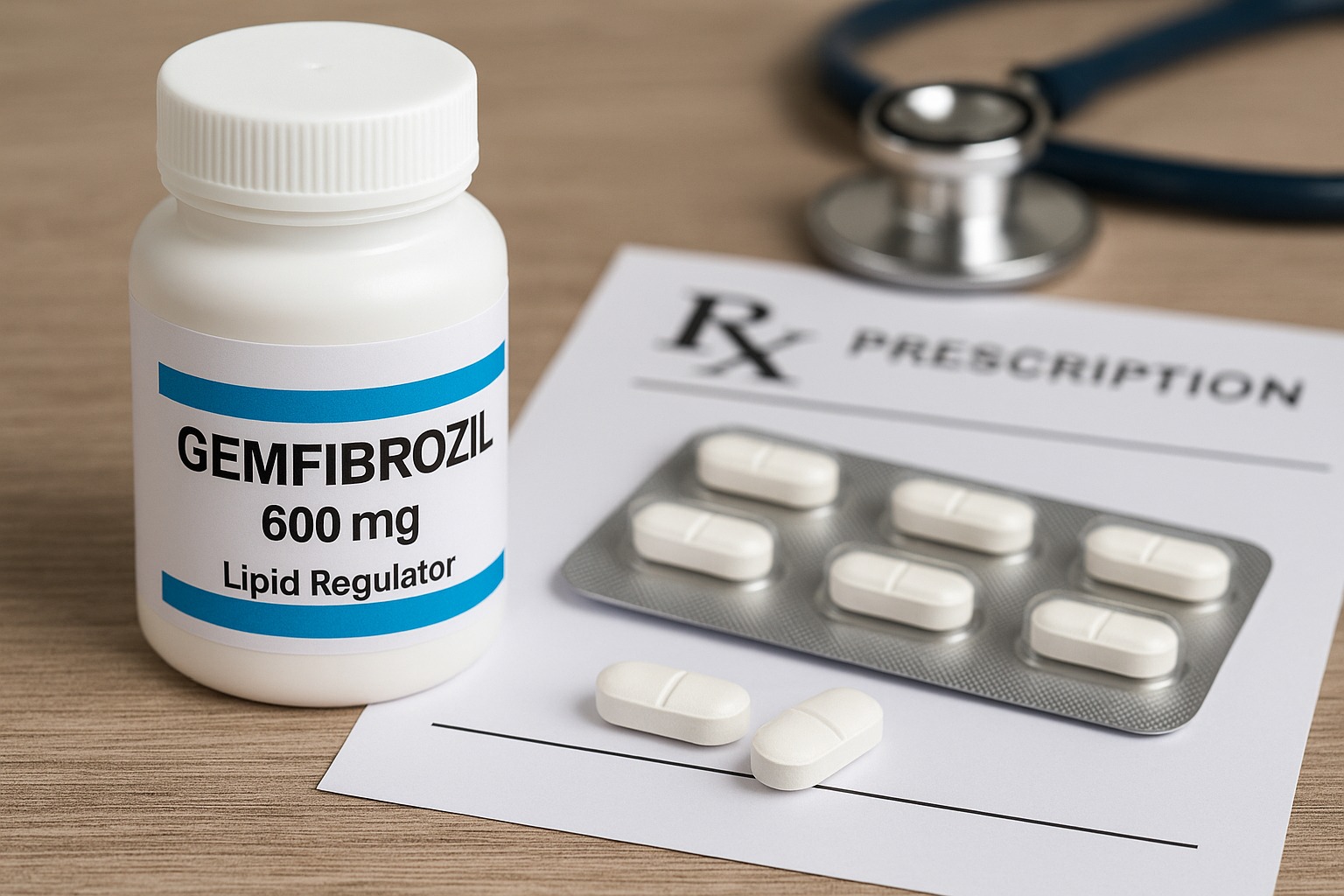Gemfibrozil is a prescription medication used to lower cholesterol and triglycerides (fatty acids) in your blood. Its brand name is Lopid, and it belongs to a class of drugs called fibrates. By improving lipid levels, Gemfibrozil helps reduce the risk of heart disease, pancreatitis, and related complications.
Doctors usually prescribe Gemfibrozil for adults with very high triglycerides, or in some cases, for people who cannot control cholesterol with statins alone. It is taken as an oral tablet, not an injection or infusion.
In this clear guide, you’ll learn what Gemfibrozil is, how it works, when doctors prescribe it, how to take it, possible side effects, safety tips, and answers to the most-searched questions (dosage, brand name, uses, cost, and more).
Disclaimer: This article is for educational purposes only. It is not a substitute for professional medical advice. Always follow your healthcare provider’s instructions.
What Is Gemfibrozil?
- Brand name: Lopid
- Generic name: Gemfibrozil
- Drug type: Fibrate (lipid-lowering medicine)
- Form: 600 mg oral tablets
Gemfibrozil is not a statin. Instead, it works in a different way to control blood fats, mainly lowering triglycerides and raising HDL (“good” cholesterol).
How Does Gemfibrozil Work?
Gemfibrozil targets abnormal fat metabolism in the body. It:
- Lowers triglycerides by reducing liver production of very-low-density lipoproteins (VLDL).
- Increases HDL (“good” cholesterol), which helps remove bad cholesterol from your bloodstream.
- Improves the balance of cholesterol and fats, reducing the risk of blocked arteries.
Because it affects fat metabolism, Gemfibrozil is especially useful in people with extremely high triglycerides, where the risk of pancreatitis is high.
Common Uses of Gemfibrozil
Doctors prescribe Gemfibrozil for several conditions:
1. Very High Triglycerides
- Prevents pancreatitis in patients with severe hypertriglyceridemia.
2. Mixed Dyslipidemia
- Sometimes used when patients cannot tolerate statins, or when statins alone are not enough.
3. Coronary Heart Disease Risk Reduction
- May be prescribed to lower the risk of heart-related complications in people with abnormal cholesterol profiles.
Gemfibrozil Dosage and Administration
- Typical dose: 600 mg tablet taken twice daily, 30 minutes before breakfast and dinner.
- Do not take with food: Taking Gemfibrozil before meals helps your body absorb it properly.
- Missed dose: If you forget, skip it and take the next scheduled dose. Do not double up.
Your doctor may adjust your treatment based on lab results and how your body responds.
Side Effects of Gemfibrozil
Common Side Effects
- Stomach upset or indigestion
- Nausea, vomiting, or diarrhea
- Fatigue
- Headache or dizziness
- Rash or mild skin irritation
Serious Side Effects (seek medical help immediately)
- Muscle pain, tenderness, or weakness (especially when combined with statins—may indicate muscle injury or rhabdomyolysis)
- Liver problems (yellowing skin/eyes, dark urine)
- Gallstones (upper abdominal pain, nausea after fatty meals)
- Severe allergic reactions (rare)
Safety Tips With Gemfibrozil
- Drug interactions: Gemfibrozil should not be combined with certain statins (like simvastatin) because of muscle damage risk. Always share your medication list with your doctor.
- Liver & kidney health: Regular blood tests are needed to check liver function and kidney health.
- Pregnancy & breastfeeding: Not usually recommended; consult your doctor.
- Alcohol: Limit alcohol, as it can worsen triglycerides and stress the liver.
Gemfibrozil vs. Other Lipid-Lowering Drugs
- Compared to statins: Statins mainly lower LDL (“bad” cholesterol), while Gemfibrozil mainly lowers triglycerides and increases HDL.
- Compared to fenofibrate: Both are fibrates, but fenofibrate may be preferred for some patients because of fewer interactions with statins.
- Combination therapy: Sometimes used with statins, but only under close medical supervision due to muscle risk.
Cost and Access
- Gemfibrozil is available as a generic medication, which is generally affordable.
- Brand name Lopid may cost more, but generics provide the same effect.
- Prices vary by pharmacy and insurance coverage. Patient assistance programs may be available.
Frequently Asked Questions (FAQs)
Q1. What is Gemfibrozil used for?
It’s mainly prescribed to lower very high triglycerides and reduce pancreatitis risk. It can also improve cholesterol balance.
Q2. How long does it take for Gemfibrozil to work?
Blood lipid levels often improve within a few weeks, but you’ll need regular lab checks to confirm progress.
Q3. Can I take Gemfibrozil with statins?
Sometimes, but this combination increases the risk of muscle damage. Only take together if your doctor recommends it and monitors you closely.
Q4. What foods should I avoid on Gemfibrozil?
Limit alcohol and high-fat foods. Follow a heart-healthy diet to maximize results.
Q5. Is Gemfibrozil safe long-term?
Yes, if monitored correctly with regular lab tests. Many people take it for years under medical supervision.
Final Thoughts
Gemfibrozil (Lopid) is an effective medication for lowering triglycerides and improving cholesterol balance. By reducing harmful fats in the blood, it can help lower the risk of serious complications like pancreatitis and heart disease.
To get the best results, take Gemfibrozil exactly as prescribed, maintain a healthy diet, and follow up with regular lab tests. Always work closely with your doctor to monitor side effects and adjust treatment when needed.


Leave a Comment